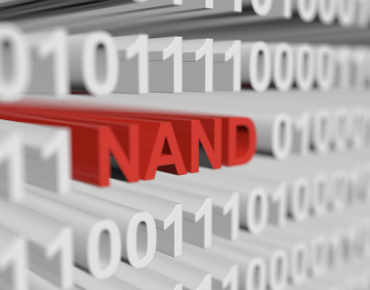With Optane Gaining, Intel Exits NAND Flash

via Shutterstock
In a sign that its 3D XPoint memory technology is gaining traction, Intel Corp. is departing the NAND flash memory and storage market with the sale of its manufacturing base in China to SK Hynix of South Korea.
The $9 billion transaction announced early Tuesday (Oct. 20) does not include Intel’s Optane persistent memory technology. The chip maker (NASDAQ: INTC) said it intends to use proceeds from the sale to invest in further development of Optane as the memory technology makes inroads in enterprise datacenters.
SK Hynix (KRX: 000660), a leader among global memory manufacturers, will acquire Intel’s NAND storage business as well as its NAND wafer fab in Dalian, China. The Seoul-based chip maker said it would make an initial payment of $7 billion to acquire the Dalian facility along with design and manufacturing intellectual property associated with Intel’s NAND SSD operations.
The remaining $2 billion will be paid at closing, SK Hynix said. Intel will continue to manufacture NAND wafer at the Dalian fab until March 2025, when the transaction is expected to close.
Along with Intel’s NAND SSD technology, the deal gives Hynix the U.S. chip maker’s quad-level cell NAND flash portfolio.
Intel and SK Hynix have collaborated on DRAM development in the past, most recently DDR5 memory technology. SK Hynix CEO Seok-Hee Lee said memory technology collaboration would now extend to NAND flash development.
The South Korean memory maker announced a 128-layer 4D NAND flash device last year based on its proprietary Charge Trap Flash technology, promoting it as enabling “terabyte” smartphones. Much of its NAND flash memory ends up in smartphones. The deal for Intel’s memory technology would give SK Hynix an entrance into new datacenter and edge computing markets, observers noted.
The Korean chip maker said it would incorporate Intel’s NAND flash technology and its memory manufacturing techniques as it targets higher value-added markets such as enterprise storage drives.
Intel has been steadily exiting the DRAM and other memory market segments as it concentrated on extending the life cycle of its dominant x86 processors. It has poured billions of dollars into development and production of its Optane persistent memory based on 3D XPoint technology jointly developed with Micron Technology.
Industry analysts said the NAND flash selloff indicates that Optane may finally be turning a profit as Intel targets growing in-memory processing demands in datacenters and the cloud. Intel CEO Bob Swan indicated as much in announcing the deal.
“This transaction will allow us to further prioritize our investments in differentiated technology,” Swan said.
The NAND flash sale, which initially amounts to a joint venture between Intel and SK Hynix, gives the South Korean memory maker a boost in the NAND flash market dominated by Samsung Electronics. According to IHS Markit, Samsung controls more than 35 percent of global NAND flash business.
The deal for Intel’s technology would make SK Hynix the No.2 NAND flash manufacturer.
Related
George Leopold has written about science and technology for more than 30 years, focusing on electronics and aerospace technology. He previously served as executive editor of Electronic Engineering Times. Leopold is the author of "Calculated Risk: The Supersonic Life and Times of Gus Grissom" (Purdue University Press, 2016).










